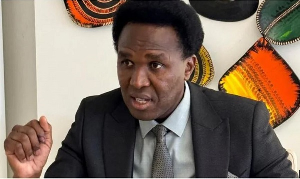Accra, Oct. 28, GNA - The Agricultural Development Bank (ADB) gave out 1.93 trillion cedis as credit for agricultural development between 1996 and 2004, Rev. Dr. Samuel Asuming-Brempong, Lecturer, Agricultural Economics, University of Ghana Legon, said on Thursday. The amount constituted 50 per cent of ADB's total investment portfolio and 85 per cent of credit for agricultural development nationwide, over the period.
Dr. Asuming-Brempomg was speaking at ADB's 40th Anniversary lecture on the topic: ADB - Forty years of leadership in agricultural financing in Ghana.
The lecture was the third since the celebration started earlier this year.
Dr. Asuming-Brempong noted that ADB's investments in agricultural development made ADB it the leader in developing the sector. He said out of the total amount, 46.89 per cent went into industrial crops, 29.17 per cent into cocoa production and marketing, 23.16 per cent, for food crops, 6.19 per cent into poultry and livestock while non-traditional products took 5.7 per cent.
Dr. Asuming-Brempong noted that ADB invested more in industrial crops and cocoa to the detriment of food crops, poultry and livestock and the non-traditional products and said the Bank should back-up in those areas since they formed a major part of the agricultural sector. He observed that ADB made the level of investment into the industrial crops and cocoa sectors because they were more organised and suggested that the Bank should take the initiative to assist the other sectors to get organised for support.
Dr. Asuming-Brempong described ADB as the backbone of the agricultural sector, which contributed 35 per cent of the Gross Domestic Product (GDP), 35 per cent of foreign exchange and employed 60 per cent of the country's workforce.
He noted that the challenge that faced ADB however was the recovery of its credits and loans.
"2002 recorded the highest recovery rate of 65 per cent from the commercial scheme portfolio and the year 2000 recorded the lowest recovery rate from that same portfolio, whilst for the sector scheme portfolio, year 2000 recorded the highest recovery rate of 51 per cent and 2002 recorded the lowest of 35 per cent," he said.
Dr. Asuming-Brempong urged the bank to evolve more innovative ways of recovering loans to cut down the loan default rate.
He suggested that the bank should invest more in agricultural research especially in the areas where it gave the lowest credit to identify more opportunities for greater investment.
"Just us the bank made research into corporate banking and is making strides in it corporate banking sector, so also it must commit funds into research in the agricultural sector to boost its investment and gains from that sector," he said.
Dr. Asuming-Brempong stressed the need for the ADB to change its logo from a hoe and paddle in a green circle to something that reflected its vision to modernise agriculture.
Mr. Edward Boakye-Agyeman, Managing Director of ADB, said the Bank would continue to invest in the modernisation of agriculture but would maintain its current logo because the logo reflected, "Where the bank came from".
"Indeed even now most subsistence farmers continue to use hoes and the fishermen continue to use the paddle so there is nothing wrong with identifying with our roots," he argued.
He said the bank was already supporting research at the Atomic Energy Commission and was due to support research at the Centre for Scientific and Industrial Research (CSIR).
He expressed worry over that situation where research findings were left on the shelves and in the archives, saying that when that happened the money invested was wasted.
In a speech read on her behalf, Mrs Gladys Asmah, Minister for Fisheries, praised ADB for establishing itself as the main source of institutional financing to the agricultural sector, saying ADB was indeed the backbone of the economy.
Mr. Emmanuel Newman Afful, former Managing Director of ADB, who presided, supported the current Managing Director on the logo, saying it was, was still relevant to the situation in the agricultural sector. He urged the bank to find ways of supporting the domestic poultry and livestock sectors to assist in cutting down on imports.
Click to view details



Business News of Friday, 28 October 2005
Source: GNA
















